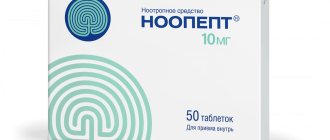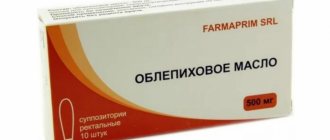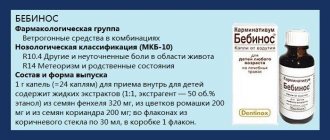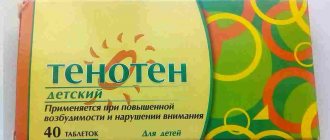Release forms and composition of the drug
The medicine is produced in the form of effervescent soluble tablets. Their main active ingredient is ibuprofen.
Additional components:
- 0.3 g potassium carbonate;
- 0.01 g anhydrous sodium carbonate;
- 0.33 g citric acid;
- 0.29 g monosodium citrate;
- 1.34 g sodium bicarbonate;
- 0.04 g sodium saccharinate;
- 0.01 g sucrose palminate;
- 0.01 g menthol flavoring;
- 0.04 g flavoring (grapefruit flavor);
- magnesium stearate – until the capsule weight is 2.8 g.
The product is packaged in aluminum strips and packaged in cardboard boxes.
Pharmacological properties
The medicine is a derivative of phenypropionic acid. It belongs to the class of non-steroidal anti-inflammatory drugs (NSAIDs). The action of the components of the drug is aimed at suppressing and inhibiting the production of cyclooxygenase. The enzyme is a precursor of prostaglandins and is involved in the development of inflammatory reactions, pain and fever.
The analgesic effect is achieved by inhibiting the synthesis of prostaglandins in the central nervous system. In this case, a decrease in platelet aggregation is observed. The main components eliminate signs of joint stiffness and increase motor function in the joints.
Pharmacological action of Advil
The active substance of the drug Advil is a non-steroidal anti-inflammatory drug with analgesic and antipyretic effects.
The mechanism of action of the drug is associated with inhibition of the main metabolic enzyme, arachidonic acid, which plays an important role in the development of pain, inflammation and fever. In addition, Advil, according to the instructions, helps suppress platelet aggregation.
The drug Advil is intended for symptomatic therapy, and it does not affect the progression of the disease.
Pharmacodynamics and pharmacokinetics
When administered orally, the active component of the drug is almost completely absorbed from the gastrointestinal tract. In this case, there is a decrease in absorption capacity while eating food.
The main substance is metabolized mainly in the liver - about 90%. The half-life of metabolites is 2-3 hours. Approximately, about 80% of the dosage of the drug is excreted in the urine in the form of metabolites. About 10% of the components are excreted from the body unchanged. 20% of the drug dosage is excreted through the intestines in the form of metabolites.
Indications for use
Advil is an American tablet that is often prescribed as part of a complex treatment of degenerative and inflammatory processes in the joints.
Indications:
- rheumatoid arthritis;
- rheumatoid arthritis;
- presence of osteoarthritis;
- relapses of gout accompanied by joint disorders;
- bursitis;
- radiculitis;
- ankylosing type of spondylitis;
- development of tendinitis;
- inflammatory processes in the area of soft tissues and the musculoskeletal system caused by various injuries.
The medication is also used in the treatment of infectious and inflammatory processes in the ENT organs: adnexitis, algodismenorrhea, pain syndrome. The drug exhibits a therapeutic effect against headaches, toothaches, and feverish conditions caused by infectious and inflammatory processes.
Contraindications
The medicine is contraindicated in the presence of hypersensitivity to the main component, as well as during pregnancy (3rd trimester).
Additional contraindications:
- kidney and liver dysfunction;
- disorders in the hematopoietic system;
- lesions in the area of the optic nerve;
- the presence of erosions and ulcers in the gastrointestinal tract during an exacerbation;
- asthmatic triad.
The drug can be prescribed during breastfeeding only with the permission of the treating specialist.
Instructions for use, dosage of the drug
Advil - American tablets that must be used according to the instructions of a specialist or the recommendations noted in the instructions. The dosage is selected individually according to the established form of the disease and clinical manifestations.
American Advil tablets are very expensive compared to domestic ibuprofen
- When taking capsules orally, a single dosage should not exceed 0.2-0.8 g. Take 3-4 times a day.
- In childhood, the dosage is calculated according to the child’s weight - 20 mg/kg/day several times a day.
- When used externally, the duration of therapy varies between 2-3 weeks.
The maximum permissible dose per day is no more than 2.4 g.
Advil
Dosage form:
dragees, oral drops, capsules, extended-release capsules, syrup, oral suspension, oral suspension [for children], tablets, lozenges, lozenges [lemon], lozenges
Pharmachologic effect:
NSAIDs; has an analgesic, antipyretic and anti-inflammatory effect due to the non-selective blockade of COX1 and COX2 and has an inhibitory effect on the synthesis of Pg. The analgesic effect is most pronounced for inflammatory pain. Like all NSAIDs, ibuprofen exhibits antiplatelet activity.
Indications:
Inflammatory and degenerative diseases of the musculoskeletal system: rheumatoid, juvenile chronic, psoriatic arthritis, osteochondrosis, neuralgic amyotrophy (Personage-Turner disease), arthritis in SLE (as part of complex therapy), gouty arthritis (in case of an acute attack of gout, fast-acting dosage forms are preferred) , ankylosing spondylitis (ankylosing spondylosis). Pain syndrome: myalgia, arthralgia, ossalgia, arthritis, sciatica, migraine, headache (including menstrual syndrome) and toothache, cancer, neuralgia, tendinitis, tendovaginitis, bursitis, neuralgic amyotrophy (Personage-Turner disease) , post-traumatic and postoperative pain syndrome, accompanied by inflammation. Algodismenorrhea, inflammatory process in the pelvis, incl. adnexitis, childbirth (as an analgesic and tocolytic agent). Feverish syndrome with “colds” and infectious diseases.
Contraindications:
Hypersensitivity, erosive and ulcerative diseases of the gastrointestinal tract (including peptic ulcer of the stomach and duodenum in the acute stage, ulcerative colitis, peptic ulcer, Crohn's disease - nonspecific ulcerative colitis), "aspirin" asthma, blood clotting disorders (in including hemophilia, prolongation of bleeding time, bleeding tendency, hemorrhagic diathesis), pregnancy, lactation period. With caution. Cirrhosis of the liver with portal hypertension, hyperbilirubinemia, peptic ulcer of the stomach and duodenum (history), gastritis, enteritis, colitis; liver and/or kidney failure, nephrotic syndrome; CHF, arterial hypertension; blood diseases of unknown etiology (leukopenia and anemia), childhood (for tablet forms - up to 12 years, 6 months - for oral suspension). Children 6-12 months are prescribed only on the recommendation of a doctor.
Side effects:
From the digestive system: NSAID gastropathy (nausea, vomiting, abdominal pain, heartburn, loss of appetite, diarrhea, flatulence, pain and discomfort in the epigastric region), ulceration of the gastrointestinal mucosa (in some cases complicated by perforation and bleeding); irritation, dryness of the oral mucosa or pain in the mouth, ulceration of the gum mucosa, aphthous stomatitis, pancreatitis, constipation, hepatitis. From the respiratory system: shortness of breath, bronchospasm. From the senses: hearing loss, ringing or noise in the ears, reversible toxic optic neuritis, blurred vision or diplopia, dryness and irritation of the eyes, swelling of the conjunctiva and eyelids (allergic origin), scotoma. From the nervous system: headache, dizziness, insomnia, anxiety, nervousness and irritability, psychomotor agitation, drowsiness, depression, confusion, hallucinations, rarely - aseptic meningitis (more often in patients with autoimmune diseases). From the cardiovascular system: development or worsening of heart failure, tachycardia, increased blood pressure. From the urinary system: acute renal failure, allergic nephritis, nephrotic syndrome (edema), polyuria, cystitis. Allergic reactions: skin rash (usually erythematous, urticaria), skin itching, angioedema, anaphylactoid reactions, anaphylactic shock, bronchospasm, fever, erythema multiforme exudative (including Stevens-Johnson syndrome), toxic epidermal necrolysis (Lyell's syndrome) , eosinophilia, allergic rhinitis. From the hematopoietic organs: anemia (including hemolytic, aplastic), thrombocytopenia and thrombocytopenic purpura, agranulocytosis, leukopenia. Other: increased sweating. The risk of developing ulcerations of the gastrointestinal mucosa, bleeding (gastrointestinal, gingival, uterine, hemorrhoidal), visual impairment (impaired color vision, scotoma, amblyopia) increases with long-term use in large doses. Overdose. Symptoms: abdominal pain, nausea, vomiting, lethargy, drowsiness, depression, headache, tinnitus, metabolic acidosis, coma, acute renal failure, decreased blood pressure, bradycardia, tachycardia, atrial fibrillation, respiratory arrest. Treatment: gastric lavage (only within an hour after administration), activated charcoal, alkaline drinking, forced diuresis, symptomatic therapy (correction of CBS, blood pressure).
Directions for use and dosage:
Inside, after eating. Adults: for osteoarthritis, psoriatic arthritis and ankylosing spondylitis - 400-600 mg 3-4 times a day. For rheumatoid arthritis - 800 mg 3 times a day; for soft tissue injuries, sprains - 1.6-2.4 g/day in several doses. For algodismenorrhea - 400 mg 3-4 times a day; for moderate pain syndrome - 1.2 g/day. For children over 12 years of age, the initial dose is 150-300 mg 3 times a day, the maximum dose is 1 g, then 100 mg 3 times a day; for juvenile rheumatoid arthritis - 30-40 mg/kg/day in several doses. To reduce body temperature 39.2 degrees C and above - 10 mg/kg/day, below 39.2 degrees C - 5 mg/kg/day. Oral suspension - 5-10 mg/kg 3 times a day: children aged 6-12 months (only as prescribed by a doctor) - an average of 50 mg 3-4 times a day, 1-3 years - 100 mg 3 times per day, 4-6 years - 150 mg 3 times a day, 7-9 years - 200 mg 3 times a day, 10-12 years - 300 mg 3 times a day. For febrile syndrome after immunization - 50 mg, if necessary, after 6 hours, repeat administration at the same dose, maximum daily dose - 100 mg.
Special instructions:
During treatment, monitoring of the peripheral blood picture and the functional state of the liver and kidneys is necessary. When symptoms of gastropathy appear, careful monitoring is indicated, including esophagogastroduodenoscopy, a blood test to determine Hb, hematocrit, and a stool test for occult blood. To prevent the development of NSAID gastropathy, it is recommended to combine it with PgE drugs (misoprostol). If it is necessary to determine 17-ketosteroids, the drug should be discontinued 48 hours before the study. Patients should refrain from all activities that require increased attention, rapid mental and motor reactions. During the treatment period, ethanol intake is not recommended.
Interaction:
Inducers of microsomal oxidation (phenytoin, ethanol, barbiturates, rifampicin, phenylbutazone, tricyclic antidepressants) increase the production of hydroxylated active metabolites, increasing the risk of severe hepatotoxic reactions. Microsomal oxidation inhibitors reduce the risk of hepatotoxicity. Reduces the hypotensive activity of vasodilators (including BMCC and ACE inhibitors), natriuretic and diuretic activity - furosemide and hydrochlorothiazide. Reduces the effectiveness of uricosuric drugs, enhances the effect of indirect anticoagulants, antiplatelet agents, fibrinolytics (increasing the risk of hemorrhagic complications), ulcerogenic effect with bleeding of MCS and GCS, colchicine, estrogens, ethanol; enhances the effect of oral hypoglycemic drugs and insulin. Antacids and cholestyramine reduce the absorption of ibuprofen. Increases the blood concentration of digoxin, Li+ drugs and methotrexate. Caffeine enhances the analgesic effect. When administered simultaneously, ibuprofen reduces the anti-inflammatory and antiplatelet effects of ASA (an increase in the incidence of acute coronary insufficiency in patients receiving small doses of ASA as an antiplatelet agent is possible after starting ibuprofen). When prescribed with anticoagulant and thrombolytic drugs (alteplase, streptokinase, urokinase), the risk of bleeding simultaneously increases. Cefamandole, cefaperazone, cefotetan, valproic acid, plicamycin increase the incidence of hypoprothrombinemia. Myelotoxic drugs increase the manifestations of hematotoxicity of the drug. Cyclosporine and Au preparations enhance the effect of ibuprofen on Pg synthesis in the kidneys, which is manifested by increased nephrotoxicity. Ibuprofen increases the plasma concentration of cyclosporine and the likelihood of developing its hepatotoxic effects. Drugs that block tubular secretion reduce excretion and increase plasma concentrations of ibuprofen.
Side effects
The drug can cause various side effects related to the physiological characteristics of the patient.
Side effects:
- From the digestive system: discomfort in the abdomen, nausea and vomiting, diarrhea, formation of erosions and ulcers in the gastrointestinal tract, bleeding; in rare cases, functional liver disorders may develop.
- From the nervous system: dizziness and headaches, increased excitability, sleep disorders, decreased visual ability.
- From the hematopoietic system: development of anemic syndrome; agranulocytosis, thrombocytopenia.
- From the urogenital tract: functional disorders of the kidneys.
- Allergic signs: rashes, Quincke's edema, spasms in the bronchi, aseptic form of meningitis.
- Local manifestations: possible development of hyperemia, burning sensation and unpleasant tingling.
If reactions develop that are not noted in the instructions, you should consult a specialist.
Overdose
Tablets that exceed the specified dose can cause various negative manifestations. In this regard, it is recommended to strictly adhere to the dosage prescribed by the American manufacturer, specified in the official instructions for Advil.
Symptoms of drug overdose are associated with signs of ibuprofen overdose: nausea and vomiting, drowsiness, dizziness, abdominal pain, low blood pressure, renal and hepatic disorders, acidosis.
In rare cases, a decrease in pressure, confusion or loss of consciousness is observed, respiratory depression is noted, convulsions and hyperkalemia develop.
Motilium lozenges 10 mg 10 pcs.
Anticholinergic drugs may counteract the effect of Motilium. The bioavailability of Motilium when taken orally decreases after previous administration of cimetidine or sodium bicarbonate. Antacids and antisecretory drugs should not be taken simultaneously with domperidone, as they reduce its bioavailability after oral administration. The main role in the metabolism of domperidone is played by the CYP3A4 isoenzyme. In vitro studies and clinical experience indicate that concomitant use of drugs that significantly inhibit this isoenzyme may cause increased plasma concentrations of domperidone. Potent CYP3A4 inhibitors include: - Azole antifungals such as fluconazole, itraconazole, ketoconazole and voriconazole; - Antibiotics from the macrolide group, for example, clarithromycin and erythromycin; - HIV protease inhibitors, for example, amprenavir, atazanavir, fosamprenavir, indinavir, nelfinavir, ritonavir and saquinavir; - Calcium antagonists such as diltiazem and verapamil; - Amiodarone; - Aprepitant; — Nefazodone; - Telithromycin. (Drugs marked with an asterisk also prolong the QT interval.) In a number of studies of the pharmacokinetic and pharmacodynamic interactions of domperidone with ketoconazole and erythromycin when taken orally in healthy volunteers, these drugs have been shown to significantly inhibit first-pass metabolism via the CYP3A4 isoenzyme. With simultaneous administration of 10 mg of domperidone 4 times a day and 200 mg of ketoconazole 2 times a day, a prolongation of the QT interval was observed by an average of 9.8 ms during the entire observation period, at certain points the changes ranged from 1.2 to 17.5 ms. With simultaneous administration of 10 mg of domperidone 4 times a day and 500 mg of erythromycin 3 times a day, there was an increase in the QT interval by an average of 9.9 ms during the entire observation period, at certain points the changes ranged from 1.6 to 14.3 ms. In each of these studies, the Cmax and AUC of domperidone were increased approximately threefold. It is currently unknown how elevated plasma concentrations of domperidone contribute to changes in the QT interval. In these studies, domperidone monotherapy (10 mg four times daily) resulted in QT interval prolongation of 1.6 ms (ketoconazole study) and 2.5 ms (erythromycin study), whereas ketoconazole monotherapy (200 mg twice daily) and erythromycin monotherapy (500 mg three times daily) resulted in a prolongation of the QT interval by 3.8 and 4.9 ms, respectively, during the entire observation period. In another multiple-dose study in healthy volunteers, there was no significant prolongation of the QT interval during inpatient domperidone monotherapy (40 mg four times daily for a total daily dose of 160 mg, which is 2 times the recommended maximum daily dose). However, plasma concentrations of domperidone were similar to those in studies of the interaction of domperidone with other drugs. Theoretically, since Motilium has a gastrokinetic effect, it could affect the absorption of concomitantly administered oral drugs, in particular sustained-release or enteric-coated drugs. However, the use of domperidone in patients taking paracetamol or digoxin did not affect the blood levels of these drugs. Motilium can be taken simultaneously with: - antipsychotics, the effect of which it does not enhance; - with dopaminergic receptor agonists (bromocriptine, levodopa), since it inhibits their unwanted peripheral effects, such as digestive disorders, nausea and vomiting, without affecting their central effects.
Drug interactions
The drug reduces the therapeutic effect of diuretics, as well as drugs aimed at treating hypertension. There is an increase in the effect of anticoagulants with simultaneous use of capsules.
The combined use of tablets and glucocorticosteroids leads to the risk of side effects from the gastrointestinal tract. The medication prevents the processes of binding the active substances of drugs belonging to the group of anticoagulants, hypoglycemic agents, and hydantoin derivatives.
Concomitant use with amlodipine leads to a decrease in the therapeutic effectiveness of the antihypertensive drug.
Other interactions:
- Aspirin - decreases the concentration of the active component of Advil.
- Baclofen – toxic effects.
- Warfarin – increased bleeding time, hematoma formation, microhematuria.
- Captopril – decreased antihypertensive activity.
- Metatrexate – increased toxicity.
- Colesteramine – reduces the absorption time of the active component.
Lithium preparations temporarily increase the concentration of the substance in the blood. The level of absorption of ibuprofen increases with simultaneous use of the drug with magnesium hydroxide.
Advil®
Should be avoided
simultaneous use of ibuprofen with the following drugs:
- Acetylsalicylic acid: except for low doses of acetylsalicylic acid (no more than 75 mg per day) prescribed by a doctor, since concomitant use may increase the risk or other NSAIDs may increase the risk of side effects. With simultaneous use, ibuprofen reduces the anti-inflammatory and antiplatelet effect of acetylsalicylic acid (an increase in the incidence of acute coronary insufficiency in patients receiving small doses of acetylsalicylic acid as an antiplatelet agent is possible after starting ibuprofen).
- Other NSAIDs, in particular selective COX-2 inhibitors: simultaneous use of two or more drugs from the NSAID group should be avoided due to a possible increased risk of side effects.
Carefully
The drug should be used simultaneously with the following medications.
- Anticoagulants and thrombolytic drugs: NSAIDs may enhance the effect of anticoagulants, in particular warfarin and thrombolytic drugs.
- Antihypertensive drugs (ACE inhibitors and angiotensin II antagonists) and diuretics: NSAIDs may reduce the effectiveness of drugs in these groups. In some patients with impaired renal function (eg, dehydrated patients or elderly patients with impaired renal function), coadministration of ACE inhibitors or angiotensin II antagonists and COX-inhibiting agents may result in a deterioration of renal function, including the development of acute renal failure. (usually reversible). These interactions should be considered in patients taking coxibs concomitantly with ACE inhibitors or angiotensin II antagonists. In this regard, the combined use of the above drugs should be prescribed with caution, especially in the elderly. Patients should be prevented from dehydration and consideration should be given to monitoring renal function upon initiation of this combination treatment and periodically thereafter. Diuretics and ACE inhibitors may increase the nephrotoxicity of NSAIDs.
- Glucocorticosteroids: increased risk of gastrointestinal ulcers and gastrointestinal bleeding.
- Antiplatelet agents and selective serotonin reuptake inhibitors: increased risk of gastrointestinal bleeding.
- Cardiac glycosides: simultaneous administration of NSAIDs and cardiac glycosides can lead to worsening heart failure, a decrease in glomerular filtration rate and an increase in the concentration of cardiac glycosides in the blood plasma.
— Lithium preparations: there is evidence of the likelihood of an increase in the concentration of lithium in the blood plasma during the use of NSAIDs.
- Methotrexate: there is evidence of the likelihood of an increase in the concentration of methotrexate in the blood plasma during the use of NSAIDs.
- Cyclosporine: increased risk of nephrotoxicity with simultaneous administration of NSAIDs and cyclosporine.
- Mifepristone: NSAIDs should be started no earlier than 8-12 days after taking mifepristone, as NSAIDs may reduce the effectiveness of mifepristone.
- Tacrolimus: when NSAIDs and tacrolimus are co-administered, the risk of nephrotoxicity may increase.
— Zidovudine: simultaneous use of NSAIDs and zidovudine may lead to increased hematotoxicity. There is evidence of an increased risk of hemarthrosis and hematomas in HIV-positive patients with hemophilia who received concomitant treatment with zidovudine and ibuprofen.
- Quinolone antibiotics: in patients receiving concomitant treatment with NSAIDs and quinolone antibiotics, the risk of seizures may increase.
— Myelotoxic drugs: increased hematotoxicity.
— Cefamandole, cefoperazone, cefotetan, valproic acid, plicamycin: increased incidence of hypoprothrombinemia.
- Drugs that block tubular secretion: decreased excretion and increased plasma concentrations of ibuprofen.
— Inducers of microsomal oxidation (phenytoin, ethanol, barbiturates, rifampicin, phenylbutazone, tricyclic antidepressants): increased production of hydroxylated active metabolites, increased risk of developing severe intoxications.
— Microsomal oxidation inhibitors: reducing the risk of hepatotoxicity.
— Oral hypoglycemic drugs and insulin, sulfonylurea derivatives: increased effect of drugs.
- Antacids and cholestyramine: decreased absorption.
— Uricosuric drugs: decreased effectiveness of drugs.
- Estrogens, ethanol: increased risk of side effects.
— Caffeine: increased analgesic effect.
Analogs
Advil are American tablets that have several structural analogues and are often replaced by other drugs that have a similar therapeutic effect.
| Analogue name | Features/Characteristics | Price |
| Baralgin | This medicine is based on metamizole sodium. The medication has anti-inflammatory, analgesic, antipyretic effects and is produced in the form of tablets or injection solution. The medicine is prescribed for infectious and inflammatory diseases accompanied by fever, pain and spasms. Baralgin is highly effective against radiculitis, osteochondrosis, arthritis, and myalgia. The medication is contraindicated for hepatic porphyria and lack of glucose. The dosage is calculated individually according to the disease and the age of the patient. | 160-1066 rub. |
| Ibuprofen | This pharmacological drug belongs to the class of propionic acid derivatives and is available in several dosage forms - for rectal use, intravenous administration, oral administration and external use. The drug is used for various infectious and inflammatory diseases, including radiculitis, myalgia, various forms of arthritis, osteochondrosis, ARVI, influenza, gout. The course of treatment is determined in each case separately. It is forbidden to use the product yourself, as there are extensive contraindications. | From 16 rub. |
| MIG 200 | This medical product has anti-inflammatory, antipyretic, analgesic effects and is available in capsule form. Drops are prescribed for pain caused by rheumatoid diseases, influenza, and acute respiratory viral infections. The drug is prescribed to adults and children over 12 years of age. The daily dosage is 1-2 capsules every 4-6 hours. The course of treatment is determined by a specialist. The medicine is prohibited for use in cases of peptic ulcers, bronchial asthma, liver and kidney pathologies, and heart failure. | 60-180 rub. |
Before changing the drug, you should consult a specialist.
Advil's analogs
Based on their belonging to the same pharmacological group and similar mechanism of action, the following drugs are analogues of Advil:
- Apo-Ibuprofen;
- No pain;
- Burana;
- Bonifen;
- Ibalgin;
- Brufen and Brufen Retard;
- Bren;
- Dolgit;
- Ibupron;
- Ibuprof;
- Ibusan;
- Ibuprofen;
- Ibutad;
- Ibufen;
- Ibutop;
- Markofen;
- Yprene;
- MIG 200;
- Nurofen;
- Motrin;
- Solpaflex;
- Pro-Final;
- Profen;
- Perofen 200;
- Reumafen.







